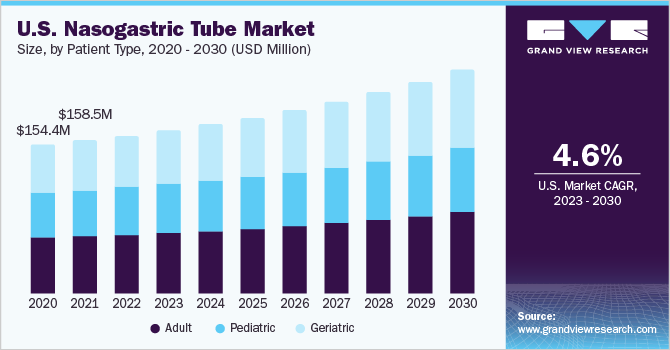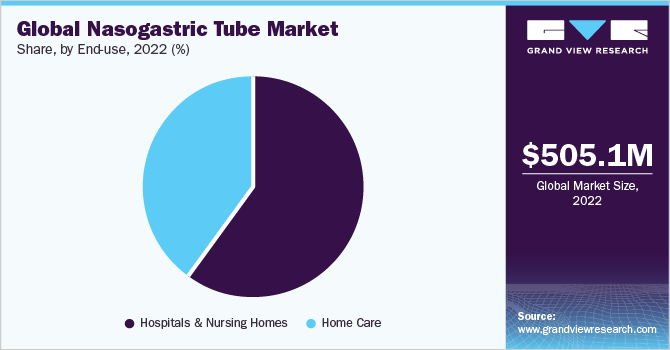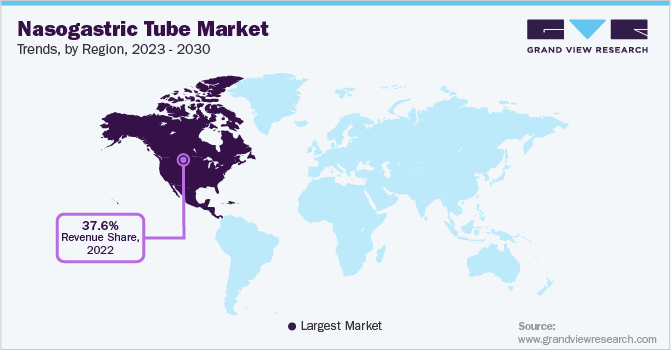- Home
- »
- Medical Devices
- »
-
Nasogastric Tube Market Size, Share & Trends Report, 2030GVR Report cover
![Nasogastric Tube Market Size, Share & Trends Report]()
Nasogastric Tube Market Size, Share & Trends Analysis Report By Patient Type (Adult, Pediatric, Geriatric), By Indication, By Type, By End-use, By Region, And Segment Forecasts, 2023 - 2030
- Report ID: GVR-4-68040-044-2
- Number of Report Pages: 180
- Format: PDF, Horizon Databook
- Historical Range: 2018 - 2021
- Forecast Period: 2023 - 2030
- Industry: Healthcare
Report Overview
The global nasogastric tube market size was valued at USD 505.1 million in 2022 and is expected to expand at a compound annual growth rate (CAGR) of 5.3% from 2023 to 2030. A nasogastric tube (NG) is used to enter the stomach through the nostrils, nasopharynx, and throat. It is a flexible tube with bidirectional potential composed of plastic and elastic. These devices can be used for enteral feeding for up to six weeks. Furthermore, the use of NG tubes is frequently prompted by the need to administer medicine and nutrients, add contrast to the stomach for X-rays, remove air or liquids from the stomach, as well as protect the bowel after surgery or while on bowel rest. Thus, propelling the market growth.

Increased demand for nasogastric tubes as a result of an increase in the prevalence of chronic diseases is anticipated to fuel the development of the global market. Another important factor that will contribute favorably to market development is the rise in the number of malnutrition patients worldwide. For instance, according to a report from the World Health Organization, 2 million individuals worldwide lack essential micronutrients like vitamins. According to the same study, malnutrition affects 40% of hospitalized patients, which has increased mortality & morbidity rates. Therefore, nasogastric tubes are the first option for providing malnourished people and people who are unable to consume nutrients orally with a sufficient amount of nutrients.
The COVID-19 pandemic resulted in an increased demand for nasogastric tubes in North America. An increase in COVID-19 patient admissions led to an increase in ICU admissions for the same in North America. In addition, most ICU patients required enteral feeding, which was administered through these devices. As a result, demand for and adoption of these tubes grew among ICU patients during the pandemic. However, the funding for enteral nutrition-related R&D activities has been decreased as a result of the medical industry's focus shifting to the treatment of COVID-19. Furthermore, the number of ICU admissions owing to COVID-19 surged from 9,245 in July 2020 to 27,748 in December 2020, according to Global Change Data Lab. In addition, according to The National Institutes of Health, a significant increase in the consumption of nasojejunal tubes & nasogastric tubes for COVID-19 patients was noted in the U.S. during the pandemic. This resulted in the expansion of the market.
The primary factors propelling the development of the nasogastric tube industry are the rising prevalence of chronic illnesses like diabetes, cancer, and cardiovascular disorders, respiratory & gastrointestinal diseases, which result in an increase in patient pools. As nasogastric tubes are increasingly needed in hospitals for enabling enteral feeding, offering medicinal support, and gastric decompression, the rising rates of hospitalization among children and the elderly will present high demand for these tubes. Additionally, emerging public awareness of the need for enteral rather than parenteral nutrition and shifting trends regarding enteral feeding will foster industry growth in the near future.
One of the key drivers of market expansion is the rising incidences of chronic diseases like cancer. Malnutrition is a common problem for cancer patients, necessitating enteral feeding through these devices. In 2022, as per Feeding Tube Awareness Week, in the U.S., approximately 500,000 infants and adults were dependent on enteral feeding. Thus, it will drive market growth.
Patient Type Insights
The adult segment held the largest share of the market in 2022, with 36.9%. The growing use of nasogastric tubes during surgical procedures is fueling the market's expansion, and it is expected that patient nutrition will be its main driver going forward. The demand for nasogastric tubes is anticipated to increase due to the growing number of adult patients. The major utilization of nasogastric tubes is in elderly patients due to the rising rate of chronic kidney diseases. As per the CDC, in 2021, 15% of adults are estimated to have CKD. Thus, it will fuel the growth of the global market.
On the other hand, the geriatric segment is anticipated to witness the fastest growth from 2023 to 2030 period. One of the main growth-stimulating causes is the rising prevalence of chronic illnesses in the U.S. such as cancer and gastrointestinal (GI) disorders. For instance, a report from the Centers for Disease Control and Prevention in June 2022 reported that the patient age group of 65 years and higher accounted for an average of 58% of all cancer cases and are expected to assist the segment to maintain its dominance during the forecast period.
Indication Insights
The others segment is the fastest-growing segment in the market. It is expected to grow at a CAGR of 7.0% between 2023 and 2030. The World Health Organization (WHO) estimates that 15 million babies are delivered preterm each year (before 37 full weeks of pregnancy), and the number is growing. In 184 countries, preterm birth rates vary from 5% to 18%. Premature babies require more frequent feedings with adequate nutrition because they have a limited supply of both energy and nutrients. To guarantee that these infants receive the optimum nutrition, nasogastric tubes are used. In light of the growing number of sick and premature infants, the nasogastric tube industry is expected to grow considerably over the next few years.
On the other hand, the dysphagia segment held 20.5% of the nasogastric tube industry share in 2022, accounting for the largest share of the market. The WHO estimates that there are 15 million strokes per year around the world, resulting in 6 million fatalities and another 6 million disabilities like eye loss and speech impediment. As a result, the global market is expanding and nasogastric tube demand is increasing due to the growing prevalence of stroke-related dysphagia as well as related pharyngeal and laryngeal issues. Thus, propelling the market growth.
Type Insights
The small-bore feeding tube segment held the largest share of the market in 2022. It is also expected to witness the fastest growth from the 2023 to 2030 period. A small-bore feeding tube is introduced to allow access to the gastrointestinal tract for patients who are unable to ingest enough calories orally. The tube is capable of being utilized to deliver nutrients, fluids, and medicines. Thus, demand for these tubes increases among the patient population and end-users.
Additionally, small-bore feeding tubes are preferred during critical disease because they reduce the chance of tissue necrosis in the nares & sinusitis. There is a lower chance of pneumonia and vomiting when small-bore feeding tubes are implanted postpylorically. Thus, it will drive market growth.
End-use Insights
The hospital segment held the largest share of the market in 2022, with a 59.7% share. The growing incidence of ingestion & gastrointestinal issues among the aging population is the main reason propelling the hospital segment. When such cases occur, essential nutrients need to be supplemented via the nasogastric route, which positively impacts the requirement for nasogastric tube feeding. The segmental growth is also being fueled by the growing elderly population, the rising prevalence of chronic illnesses, and rising hospitalizations in various regions around the globe.

Additionally, geriatric patients are more prone to digestive issues and are more likely to need nasogastric tubes for management or therapy. Therefore, the demand for nasogastric tubes in the homecare setting is increased; this is anticipated to fuel the nasogastric tube industry's expansion.
Regional Insights
North America accounted for the largest share of the nasogastric tube industry in 2022, with 37.6%. The North America region is expected to exhibit high demand during the forecast period due to the development of various regulatory guidelines in the region. For example, the U.S. FDA released guidelines in June 2021 for testing the appropriateness of oral pharmaceutical drugs for enteral feeding tube application. These advancements drive the requirement of efficient nasogastric tubes, which may be needed for the maintenance of sufficient nutrition for a variety of reasons including cancer, swallowing trouble, severe genetic or acquired neurological dysfunction, and other diseases.

The Asia Pacific region is expected to see profitable growth during the forecast period due to high unmet needs for digestive disease care facilities, as well as growing patient awareness levels about such facilities across the region, particularly in developing countries such as India, China, and Indonesia, which will boost product demand over the forecast period.
Key Companies & Market Share Insights
The continuous demand for nasogastric tubes by multiple end-users has created numerous market opportunities for major players to capitalize on. For instance, the Salem Sump Tubes from Cardinal Health allow for better intermittent as well as continuous gastric suctioning. The company also states that the tube's large lumen provides for decompression, easy evacuation of gastric contents, medication administration, and irrigation. Some prominent players in the global nasogastric tube market include:
-
BD
-
QMD
-
Angiplast Pvt. Ltd.
-
Securmed
-
Vygon
-
Medtronic
-
Andersen Products Inc.
-
Cardinal Health
-
Baihe Medical
-
Poly Medicure Limited
Nasogastric Tube Market Report Scope
Report Attribute
Details
Market size value in 2023
USD 525.1 million
Revenue forecast in 2030
USD 754.5 million
Growth rate
CAGR of 5.3% from 2023 to 2030
Base year for estimation
2022
Historical data
2018 - 2021
Forecast period
2023 - 2030
Quantitative units
Revenue in USD million, CAGR from 2023 to 2030
Report coverage
Revenue forecast, company ranking, competitive landscape, growth factors, trends
Segments covered
Patient type, indication, type, end-use, region
Regional scope
North America; Europe; Asia Pacific; Latin America; MEA
Country scope
U.S.; Canada; Germany; U.K.; France; Italy; Spain; Denmark; Sweden; Norway; China; Japan; India; South Korea; Australia; Thailand; Brazil; Mexico, Argentina; South Africa; Saudi Arabia, UAE; Kuwait
Key companies profiled
BD; QMD; Angiplast Pvt. Ltd.; Securmed; Vygon; Medtronic; Andersen Products Inc.; Cardinal Health; Poly Medicure Limited; Baihe Medical
Customization scope
Free report customization (equivalent up to 8 analysts’ working days) with purchase. Addition or alteration to country, regional & segment scope.
Pricing and purchase options
Avail customized purchase options to meet your exact research needs. Explore purchase options
Global Nasogastric Tube Market Report Segmentation
This report forecasts revenue growth at the global, regional, and country levels and provides an analysis of the latest industry trends in each of the sub-segments from 2018 to 2030. For this study, grand view research has segmented the global nasogastric tube market report based on patient type, indication, type, end-use, and region:
-
Patient Type Outlook (Revenue, USD Million, 2018 - 2030)
-
Adult
-
Pediatric
-
Geriatric
-
-
Indication Outlook (Revenue, USD Million, 2018 - 2030)
-
Stomach Cancer
-
Esophageal Cancer
-
IBD
-
Chronic Kidney Disease
-
Dysphagia
-
Others
-
-
Type Outlook (Revenue, USD Million, 2018 - 2030)
-
Small-bore feeding tubes
-
Large-bore feeding tubes
-
-
End-Use Outlook (Revenue, USD Million, 2018 - 2030)
-
Hospitals & Nursing Homes
-
Home Care
-
-
Regional Outlook (Revenue, USD Million, 2018 - 2030)
-
North America
-
U.S.
-
Canada
-
-
Europe
-
Germany
-
U.K.
-
France
-
Italy
-
Spain
-
Denmark
-
Sweden
-
Norway
-
-
Asia Pacific
-
China
-
Japan
-
India
-
South Korea
-
Australia
-
Thailand
-
-
Latin America
-
Brazil
-
Mexico
-
Argentina
-
-
Middle East & Africa
-
South Africa
-
Saudi Arabia
-
UAE
-
Kuwait
-
-
Frequently Asked Questions About This Report
b. The global nasogastric tube market size was estimated at USD 505.1 million in 2022 and is expected to reach USD 525.1 million in 2023.
b. The global nasogastric tube market is expected to grow at a compound annual growth rate of 5.3% from 2023 to 2030 to reach 754.5 million in 2030.
b. North America dominated the nasogastric tube market with a share of 37.5% in 2022. This share is attributable to easy availability of technologically advanced products and awareness among patients about nasogastric tubes.
b. Some key players operating in the nasogastric tube market includes BD, QMD, Angiplast Pvt. Ltd., Securmed, Vygon, Medtronic, Andersen Products Inc., and Cardinal Health.
b. Key factors that are driving the market growth includes rising penetration of chronic conditions such as CVD, bleeding disorders, dysphagia, and others; growing number of preterm births and increasing number of geriatric population.
Share this report with your colleague or friend.
![gvr icn]()
NEED A CUSTOM REPORT?
We can customize every report - free of charge - including purchasing stand-alone sections or country-level reports, as well as offer affordable discounts for start-ups & universities. Contact us now
![Certified Icon]()
We are GDPR and CCPA compliant! Your transaction & personal information is safe and secure. For more details, please read our privacy policy.
We are committed towards customer satisfaction, and quality service.
"The quality of research they have done for us has been excellent."





